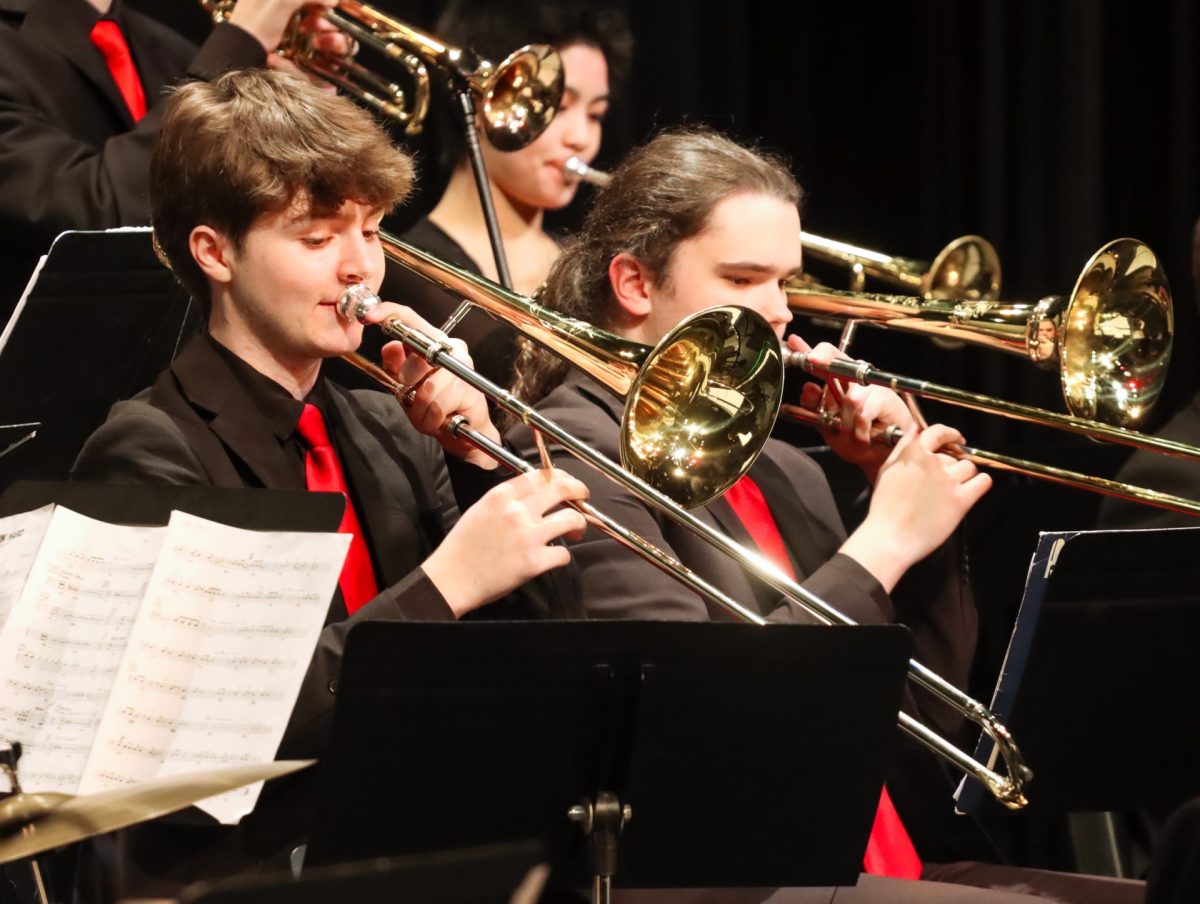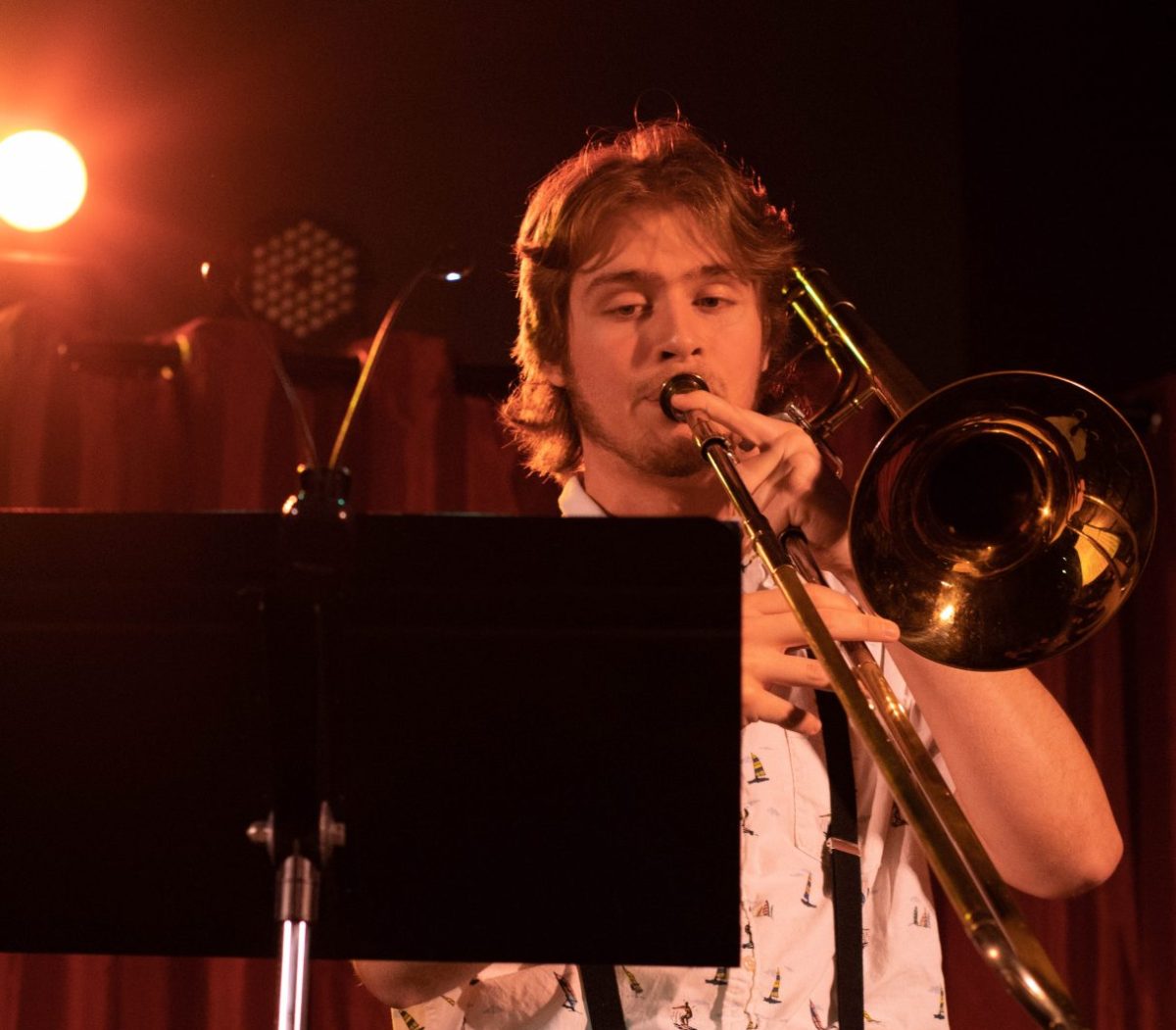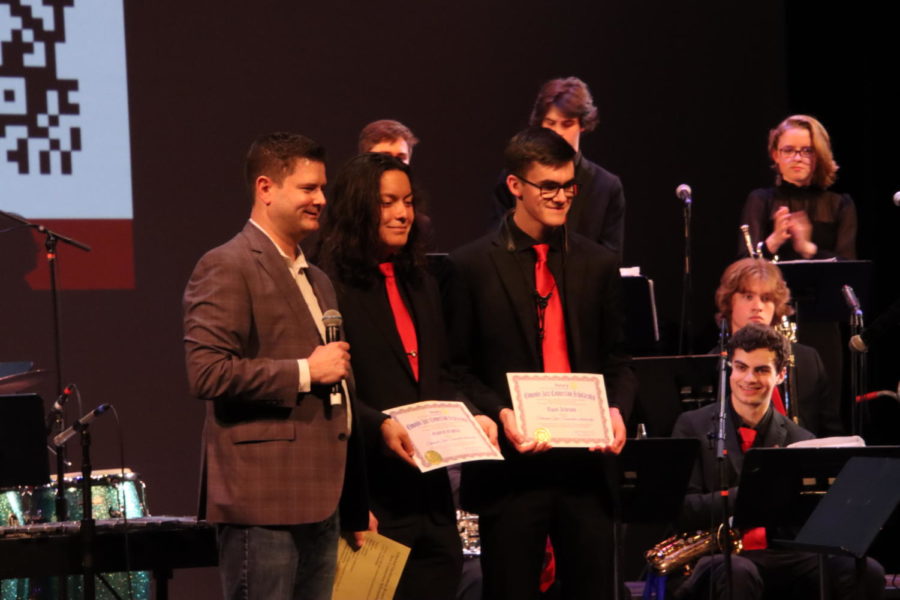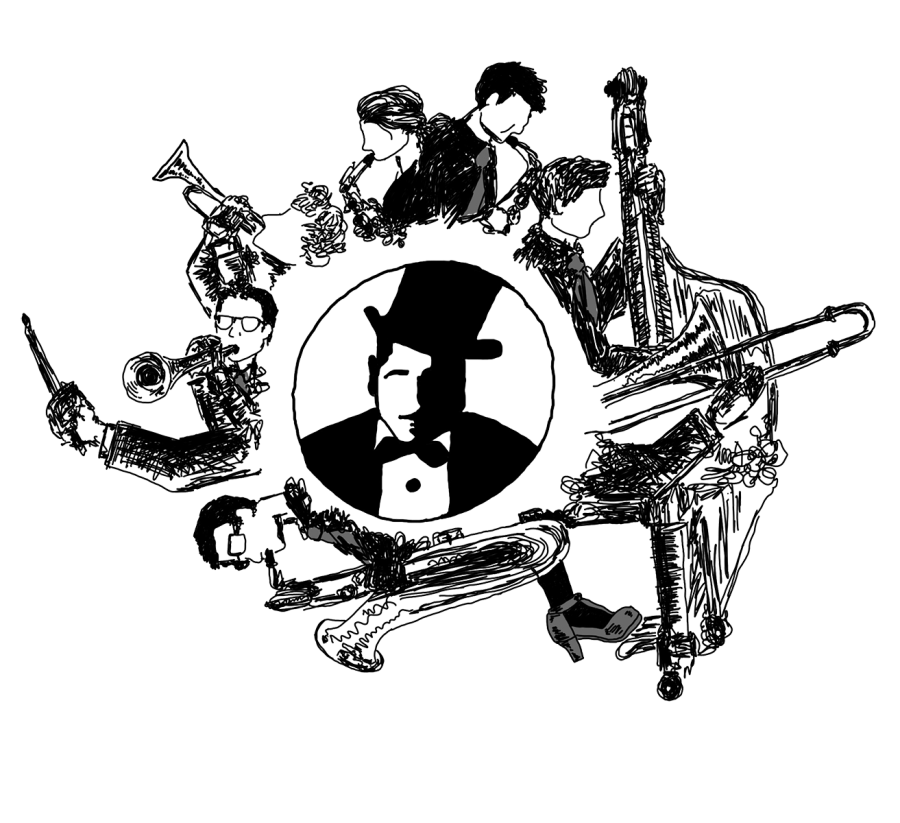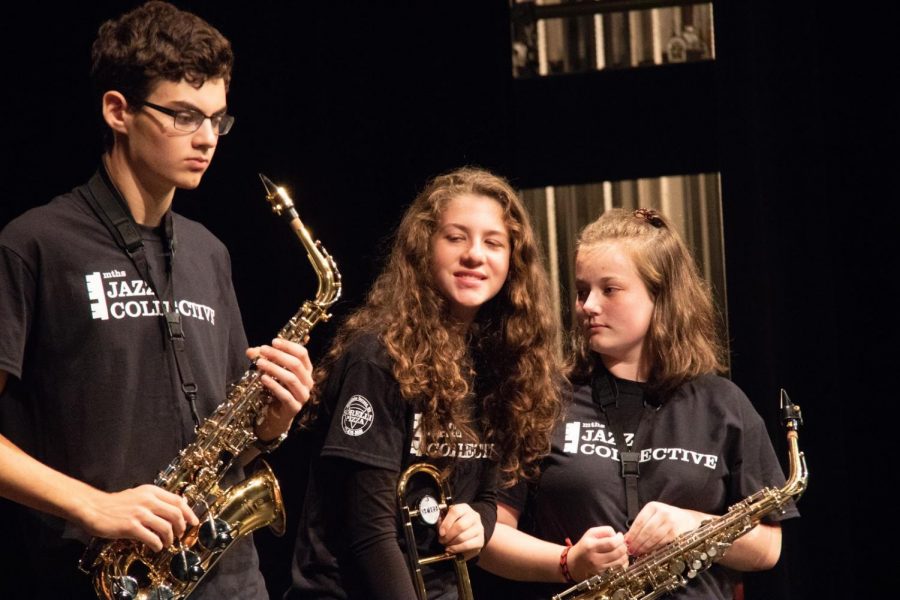Winter is perhaps the busiest time of year for the Mountlake Terrace Jazz bands. They just finished a round of clinics with esteemed musician Justin DiCioccio less than a week after coming back from a three-day retreat. Jazz 1 has begun recording for Hot Java, Cool Jazz, and they’re getting ready for a trip to the University of Oregon this January. Despite all of this, they were able to squeeze in a holiday concert on Thursday in the theater.
Jazz 2/3’s set was largely defined by the work of composer Sammy Nestico, most known for his work for the Basie band. His style is instantly recognizable by his laidback but clean and bright tone. This year, the 2/3 band is split into the Red and Black bands, each with an equal measure of experienced and new players.
Red band began with “Fancy Pants,” a thick, rich and bluesy tune with a solo from freshman Mark Tiersma on trumpet. “Fancy Pants” is the distilled spirit of the continental sort of jazz in which Nestico specialized.
The Black band played “Front Burner,” a blues shuffle that was rollicking and crisp, with a playful call and response section. Junior Jonas Rivera, whose ability has blossomed, especially in this last year, gave an outstanding tenor solo. Junior Johnny Kim and freshmen Sage Jennings on trombone and Ethan Weight on trumpet rounded out the solo section
The bands then combined, forming a monolith of suits, red ties and brass. Their final Nestico chart, “Loose Change,” was polished and nostalgic. Clinician Justin DiCioccio’s influence can be felt on the band’s performance, as this song was delivered with the kind of energy he preaches and the cohesion he accomplishes. Sophomore Connor Leaty gave a solid solo that resonated with the audience.
“I think it’s funny, they all end with the Basie lick,“ senior pianist Lindee Cutler said, in reference to the three note piano lick followed by chord hit from the whole band that is now a jazz cliché.
Festivities amped up as the lighting technicians began to add holiday-themed projections onto the walls surrounding the stage, and the combined band launched into the Christmas classic “Frosty the Snowman.” This version was brash – a snowman that kicks down your door and dances like Astaire all over your parlor. Freshman Sophia Susanto opened on piano, and Tiersma again was on trumpet. “Frosty the Snowman” wandered off the path of convention, but always came back to the familiar musical phrase by means of an intricate sax soli, showing off the unity of the section.
Jazz 1 took stage for the public debut of the pieces they will record for New York judges to evaluate as part of the Essentially Ellington competition operated by Jazz at Lincoln Center.
Their set this year shows off the range Duke Ellington was capable of writing, and that Jazz Ensemble 1 is capable of playing. The sheer variety they had to choose from is a testament to Ellington’s position as easily the greatest composer of the 20th century.
“The great trumpeter Clark Terry, who played with both the Basie and Ellington bands, once said ‘playing with Basie was like college, but Ellington was grad school,'” instructor Darin Faul said as he introduced the set.
They began with “Cotton Tail,” one of the songs which caused Ellington’s fame to skyrocket in the 1940s. It has a sense of instant familiarity, be it from the rhythm-changes, chord structure or the mere fact that it is so wildly popular. Seniors Ernesto Torres, Owen Moreland and Caden Hargrave have established themselves as the usual suspects when it comes to soloing on their respective instruments, and along with junior Natalie Song on keys and freshman Ryan Acheson on baritone sax, gave colorful performances. Senior Josh Setala’s embellished and technically impressive drumming is just one aspect of the outstanding rhythm section, along with the classically-trained junior Andrew Vinther on bass and the delightful Song on piano. Jazz 1 pulled together for an irrepressibly optimistic take on this immortal Elllington chart.
Next, they jumped to the other end of Ellington’s career for a song off of the 1967 album “The Far East Suite.” The infinitely innovative writing of both Ellington and Billy Strayhorn, inspired by the band’s tour of the Middle East, as well as the deeply atmospheric pieces that maintain blues structures make this album quintessentially Ellington.
“Isfahan,” a deeply beautiful and moving piece, was actually composed by Strayhorn a few months before the band’s trip to Iran, but it still feels influenced by its namesake city. Originally featuring a masterful solo by Johnny Hodges, the MTHS version featured Hargrave.
This isn’t Hargrave’s first time stepping into the legendary alto’s shoes – last year, he was featured on “Prelude to a Kiss” while battling food poisoning and still lived up to high expectations.
This year?
“I think I did alright,” he said. “But I was playing on Emily [Sallee]’s horn because mine was broken.”
Despite the freak obstacles that the universe keeps sending his way, it’s a good thing Hargrave doesn’t stop playing Hodges because he excels at it. While doing justice to the original, Hargrave still added an occasional flighty phrase that demonstrated his talent for improvisation and complex soloing ability. “Isfahan” is a similarly slow-burning ballad, with cheeky baritone backings from Acheson and a poignant crescendo.
“Isfahan” would be a challenging song to top, so Jazz 1 responded by going in an entirely different direction and played the Glenn Miller version of “Jingle Bells.” Layered and chordant, it added depth to the original while a sax soli established the familiar. Good fills from Setala set this piece apart, and Hargrave managed a complex and interesting solo over a Christmas carol. Also featuring senior Ethan Moore on trumpet, in typical Miller fashion this is a lush and extravagant affair, which is tastefully punctuated with delicate piano from Song. This version also nods to Miller’s most famous song, “In the Mood,” with its bridge. Here, senior trumpeter James Speedy’s ability to play ludicrously high notes is put to good use for a bombastic ending.
“Not gonna lie, the trombones killed that intro,” senior trombonist Preston Thrush bragged. “At least, we did a lot better than we have the last two days.”
The band was hitting their stride as they rolled into “Happy Go Lucky Local.” It’s a train song, a theme which is relatively common in the jazz/blues repertoire, but Ellington has arguably done it best in this piece. His aforementioned talent for the atmospheric is used here for playfully immersive effect. The rhythm section simulated the chugging of the wheels and the clacking of the tracks, while the brass had a blast pretending to be station horns.
Junior Emily Sallee broke with the opening lick, after the introductory commotion. She utilized the entire range of her alto to further add to the dynamic of this piece. Vinther and Song traded solos, Vinther with dextrous and virtuosic bass lines and Song with a rag-time inspired phrase, and Moreland gave a high-hitting clarinet solo at the very top of his register. It all ended with a rather theatrical performance from the trumpet section, who synchronously waved their hat mutes in imitation of the Doppler effect. This song solidified the upbeat tone and palpable energy of the rest of the night.
It wouldn’t be a winter concert without at least one more holiday chart, so Jazz 1 pulled out yet another Glenn Miller piece. Miller practically monopolized pop big band until his mysterious WWII disappearance, so it’s no wonder that this chart, “Sleigh Ride,” is a natural crowd-pleaser. Like “Jingle Bells,” it’s grand and ritzy. Moreland did a fine job of putting his own spin on a bridge that’s only four notes, and then thankfully was able to give an original solo only a few bars later. The song was finished with the unexpected but welcome addition of a horse’s whinny, provided by Jazz 1’s one-man sound effect department, Torres on trumpet.
By now, the audience and band were clearly enjoying themselves. Livelihood and vitality coursed through the entire theater as Jazz 1 prepared for their last piece: “Kinda Dukish/Rockin’ in Rhythm.”
The title of the song is a little confusing, but is straightforward in regard to the structure of the song, “Kinda Dukish” serves as an introduction, and was added to the original “Rockin’ in Rhythm” from the 1930s on his album “Piano in the Background.”
“Kinda Dukish” comes solely from the rhythm section, where Song, Setala and Vinther demonstrated their chops over the mainly improvised intro. Song sparkled over Vinther and Setala’s immaculate time. The band kicking in marked the end of “Kinda Dukish” and the beginning of “Rockin’ in Rhythm.” Senior trombonist Alec Raring’s brash and sassy solo filled the room. Torres, Raring and freshman Eli Faris were featured for a punchy pep-section. Acheson, wielding both his clarinet and bari sax, built the tension as Setala came in with the hollow jungle-drum sound that was an early Ellington staple. Speedy, again with his magnificent lungs, soared over the rest of the band with his crisp and ludicrously high notes. The only thing that may have topped this ending is perhaps a line of can-can dancers emerging from the wings of the theater.
“This is the most fun we’ve had at a concert in awhile,” Torres commented. “This is definitely a really great group to play with. We’ve got a great mix of new and old people who are all really enthusiastic about the music.”
While the winter jazz concert may have contained little by way of the holiday music one may expect, it provided a brief snapshot of some of the great things we can expect from the MTHS jazz program in the upcoming year.


